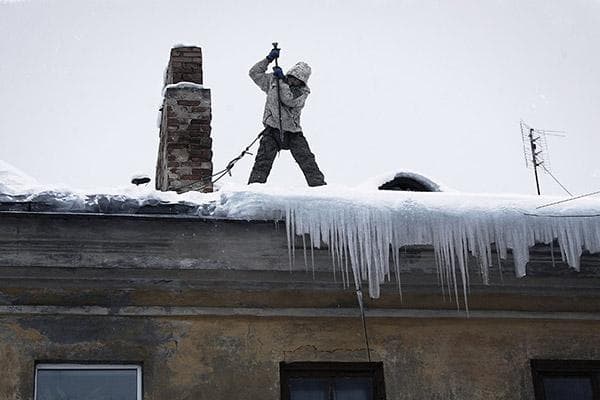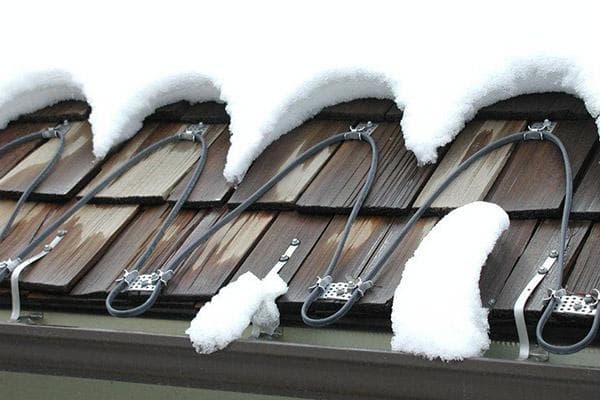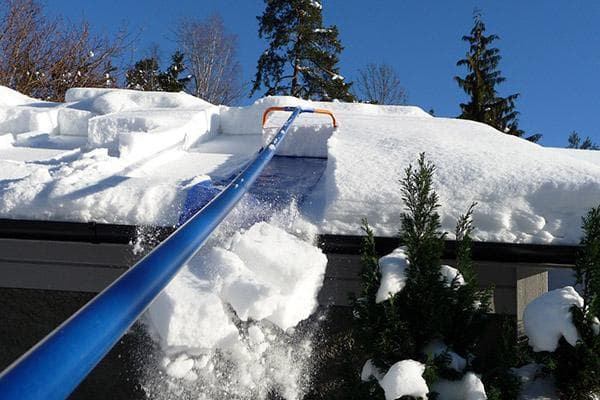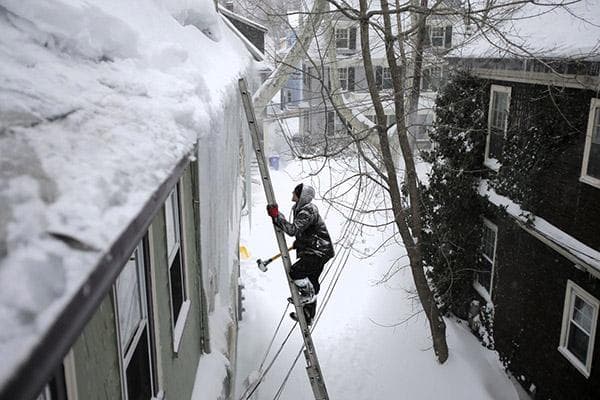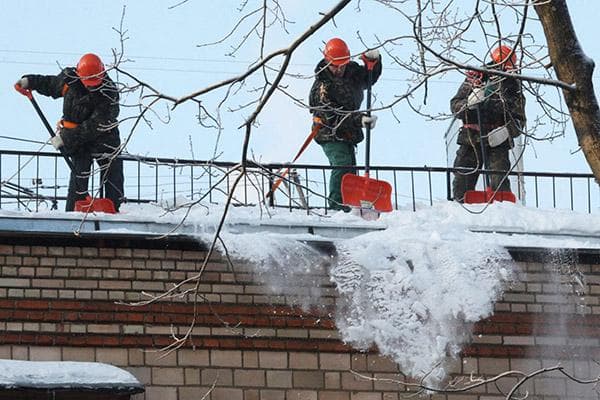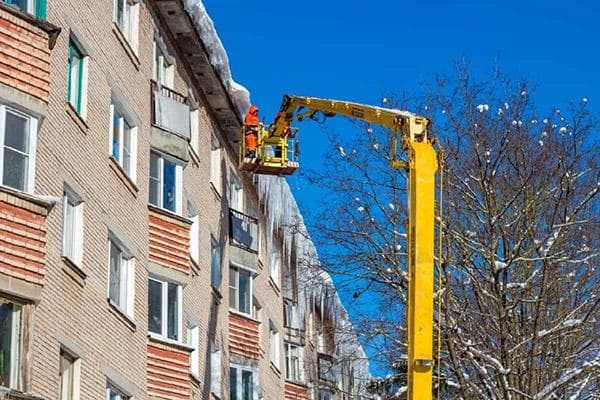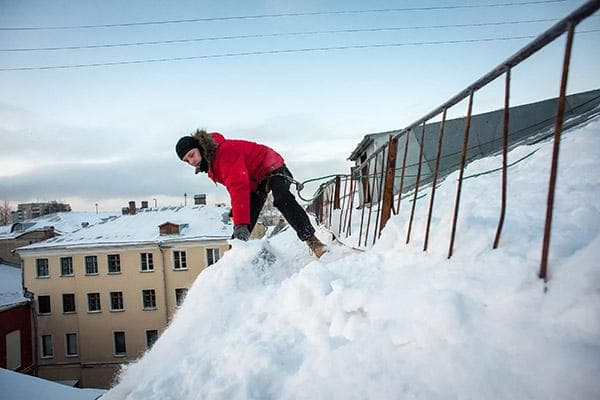Modern methods of cleaning roofs from snow and ice
Content:
Snow and ice accumulating on roofs pose a great danger to passers-by and parked cars, and can also lead to damage to the facade of the building and compromise the integrity of the roof. And massive accumulations of ice and snow can destroy the supporting structure of a house. To avoid accidents and damage to buildings, it is necessary to promptly clean the roof from snow, as well as large icicles.
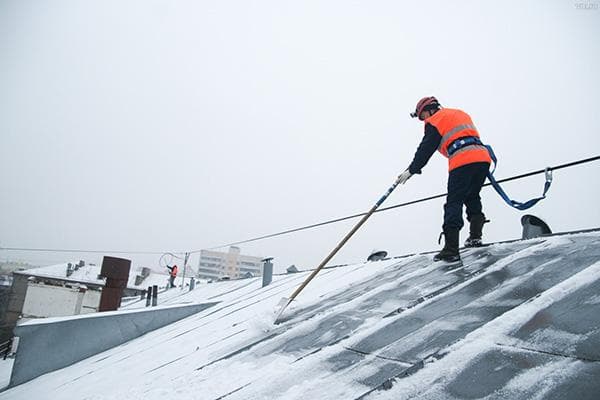
Who is responsible for clearing snow and ice from the roof?
In most cases, those responsible for cleaning roofs are:
- housing cooperatives;
- management companies;
- homeowners associations.
However, in practice, there are often cases when, after heavy snowfalls, utility services and other responsible offices are not able to cope with their work in a timely manner. A sudden thaw can cause a lot of trouble, so residents often take measures to clean themselves. Many entrust such work to guest workers or other untrained people, which leads to accidents and even bigger problems.
Basic methods for removing snow and ice
There are several ways to clear snow from your roof:
-
- Physical movement - the simplest method, involving manual cleaning. It is carried out using a snow shovel or some other object that allows you to push snow masses down. This method can only be used to remove snow and melting ice. It requires good physical preparation, great attention and caution. It can only be used during a thaw. It is impossible to break off frozen ice from the surface of roofing materials with a scraper or shovel.
- Mechanical destruction of ice blocks – with this method, compressed snow blocks are cut with an electric or chainsaw, and then they are thrown down.
- Heat – this method can be used to prevent the accumulation of huge snow masses. Heating the roof prevents snow from caking and sticking to its surface. However, if there is an existing thick layer, heating is ineffective.
- Vibration cleaning – an effective method that allows you to remove snow in any weather, even at sub-zero temperatures. However, in the presence of ice, the vibration method can only be used at positive temperatures. The advantage of the method is the ability to create vibration from the attic without climbing onto the roof and without putting yourself in danger. However, this method can only be used if the rafter system is in good working order. It should not have rotten boards or other weak points.
Cleaning methods
There are different ways to remove snow from the roof. The advisability of choosing one method or another depends on the type of roof, the thickness of the snow cover, the presence of ice, icicles, the height and configuration of the roof.
From the ground
You can clear snow while standing on the ground without resorting to the help of specialists.This method is most often used by owners of private houses, in which the distance from the lower edge of the roof to the ground does not exceed 3 m.
Cleaning is carried out using a scraper with handle lengths from 4 to 8 m. For convenience, you can prepare several replaceable handles of different lengths. Using a scraper, first remove icicles at a distance of 10–15 cm below the edge of the roof, and then remove ice and snow from the roof itself.
It is impossible to knock down icicles with strong blows near the roof - this can lead to damage to it.
From the stairs
When removing snow from one-story buildings, you can also use a ladder. The work should be carried out with the help of two assistants who must support the ladder and a safety belt. Snow and ice are cleared using a scraper and a wooden block. The latter is used for knocking down icicles.
To avoid damage by icicles to windows, façade and roof finishing, it is recommended to knock them down from the side of the house wall.
From the roof
If you need to remove snow from a flat roof, use a regular snow shovel. If there is compacted snow at least 20 cm thick, you can use a snow blower.
First of all, remove ice and snow mass around the perimeter of the roof. Then they move closer to the center and remove the second strip. In this way, you should move towards the central part of the roof. If there are low tides, care must be taken to clean the drain holes through which melt water will flow down after the thaw.
Moving on a roof with a slope of more than 26 degrees should be done using ladders and a safety rope. To prevent slipping on the roof, it is recommended to wear spiked shoes.
It is impossible to break off ice frozen to the roof using a crowbar, shovel or other devices - this can cause damage to the roof structure:
- on slate and tiles, such actions lead to the formation of cracks;
- The protective zinc layer is erased from the corrugated sheet. After 2–3 seasons, it will begin to become covered with rust, and after some time, holes will form in the rusted corrugated sheeting;
- soft roofing materials delaminate and then begin to leak.
From the attic
To remove snow from the attic, you will need several electric motors and a puck, which is usually used for playing hockey. The washer can be replaced with a wooden or iron block.
The washer will need to be placed on the motor shaft and firmly secured, moving it slightly to the edge. The result is a homemade vibrator that can clean 100-150 m² of roof. Having secured the vibrators in several places, you should warn the residents of the house so that they do not stay under the edge of the roof for 8 hours. During this time, the roof should be completely clean. You can increase the effect of this method and speed up the process by heating the snow on the roof with a gas burner.
From a self-propelled lift
Many enterprises have trucks equipped with self-propelled lifts that can rise 20–30 m. Such machines are used to clear roofs of ice and snow. To do this, a person in the lift cradle carefully knocks down icicles around the perimeter of the roof, and then uses a scraper to clean the roof itself.
You need to work in the lift carefully so as not to rock the cradle.
In what cases should the work be entrusted to specialists?
If almost every owner can cope with the problem of cleaning a private one-story house on his own, then it is better to remove ice and snow from a high-rise building with the help of experienced specialists.
It is also recommended to resort to the services of professionals in the following cases:
- The roof has a complex structure. Mansard and multi-level roofs should not be cleaned yourself.
- It is necessary to clean the roof of a 2 or more storey building. An accidental fall from a great height can cause severe injury, while specially trained industrial climbers have the necessary experience, equipment, and protective devices.
- It is necessary to clear the roof and drainage system of ice. If there is no snow on the house, but only ice, going upstairs without special training and protective equipment is extremely dangerous. The best option in this case is to call a team with a lift.
The cost of services may depend on the area of the roof, the volume and complexity of the work performed, the condition of the roof, the availability of free space under the house, as well as some other factors.
Work on clearing the roof of snow and icicles is best left to industrial climbers who have extensive experience and the necessary equipment and tools. The integrity of roofing materials and the roof itself, walls and finishing materials of the house can only be preserved if accumulated snow is removed correctly and in a timely manner.
Additionally, persons who do not clear snow properly can cause damage to the roof. And due to the lack of an official contract with them, residents will have to carry out repairs at their own expense.
